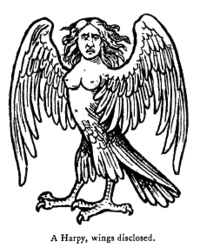
In Greek mythology and Roman mythology, a harpy (plural harpies, Greek: ἅρπυια,[1] harpyia, Latin: harpeia) was a female monster in the form of a bird with a human face. They steal food from their victims while they are eating and carry evildoers (especially those who have killed their family) to the Erinyes. They seem originally to have been wind spirits. Their name means "snatchers".[2]
Homer wrote that a harpy was the mother of the two horses of Achilles sired by the West Wind Zephyros.[3]
Hesiod calls them two "lovely-haired" creatures, the daughters of Thaumas and Electra, who were sisters of the Iris.[4] Pottery art depicting the harpies featured beautiful women with wings. Harpies as ugly winged bird-women, e.g. in Aeschylus' The Eumenides (line 50) are a late development. Roman and Byzantine writers detailed their ugliness.[5]
Mythology[]

A harpy in Ulisse Aldrovandi's Monstrorum Historia, Bologna, 1642

A medieval depiction of a harpy as a bird-woman
Phineus, a king of Thrace, had the gift of prophecy. Zeus, angry that Phineus revealed too much, punished him by blinding him and putting him on an island with a buffet of food which he could never eat. The harpies always arrived to steal the food out of his hands before he could satisfy his hunger, and befouled the remains of his food. This continued until the arrival of Jason and the Argonauts. The Boreads, sons of Boreas, the North Wind, who also could fly, succeeded in driving off the harpies, but without killing any of them, following a request from Iris, who promised that Phineus would not be bothered by the harpies again. "The dogs of great Zeus" returned to their "cave in Minoan Crete". Thankful for their help, Phineus told the Argonauts how to pass the Symplegades.[6]
In this form they were agents of punishment who abducted people and tortured them on their way to Tartarus. They were vicious, cruel and violent. They lived on the islands of the Strophades. They were usually seen as the personifications of the destructive nature of wind. The harpies in this tradition, now thought of as three sisters instead of the original two, Hesiod's two Harpies are named Aello ("storm swift") and Ocypete ("the swift wing"),[7][8] Virgil's added Celaeno ("the dark") as a third.[9] Homer knew of a Harpy named Podarge ("fleet-foot").[10]
Aeneas encountered harpies on the Strophades as they repeatedly made off with the feast the Trojans were setting. Celaeno cursed them, saying the Trojans will be so hungry they will eat their tables before they reach the end of their journey. The Trojans fled in fear.

Harpies in the infernal wood, from Inferno XIII, by Gustave Doré, 1861
Harpies remained vivid in the Middle Ages. In his Inferno, XIII, Dante envisages the tortured wood infested with harpies, where the suicides have their punishment in the seventh ring of Hell:
Here the repellent harpies make their nests,
Who drove the Trojans from the Strophades
With dire announcements of the coming woe.
They have broad wings, with razor sharp talons and a human neck and face,
Clawed feet and swollen, feathered bellies; they caw
Their lamentations in the eerie trees.[11]
William Blake was inspired by Dante's description in his pencil, ink and watercolour The Wood of the Self-Murderers: The Harpies and the Suicides (Tate Gallery, London).
See also[]
- Tantalus (Greek character condemned to never quench his hunger or thirst)
References[]
- ↑ Of uncertain etymology; Robert S. P. Beekes has suggested a Pre-Greek origin (Etymological Dictionary of Greek, Brill, 2009, p. 139).
- ↑ Adrian Room, Who's Who in Classical Mythology, p. 147 ISBN 0-517-22256-6
- ↑ Iliad xvi. 150.
- ↑ Hesiod, Theogony, 265–267.
- ↑ Virgil, Aeneid iii. 216; Ovid Metamorphoses vii.4, Fasti]' vi. 132; Hyginus, Fabula 14; Johannes Tzetzes, Ad Lycophron 653.
- ↑ Argonautica, book II; Ovid XIII, 710; Virgil III, 211, 245
- ↑ Hesiod, Theogony 265
- ↑ Pseudo-Apollodorus, Bibliotheca 1.121-123. Aello, sometimes also spelled Aellopus or Nicothoe; Ocypete, sometimes also spelled Ocythoe or Ocypode.
- ↑ Virgil, Aeneid 3.209
- ↑ Homer, Iliad 16.148
- ↑ Translation of Robert Pinsky, Boston Review
| This page uses content from the English Wikipedia. The original article was at Harpy. The list of authors can be seen in the page history. |